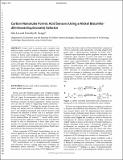Carbon Nanotube Formic Acid Sensors Using a Nickel Bis(ortho-Diiminosemiquinonate) Selector
Author(s)
Lin, Sibo; Swager, Timothy M
DownloadSwager_Carbon nanotube formic.pdf (449.6Kb)
Terms of use
Metadata
Show full item recordAbstract
Formic acid is corrosive, and a sensitive and selective sensor could be useful in industrial, medical, and environmental settings. We present a chemiresistor for detection of formic acid composed of single-walled carbon nanotubes (CNTs) and nickel bis(ortho-diiminosemiquinonate) (1), a planar metal complex that can act as a ditopic hydrogen-bonding selector. Formic acid is detected in concentrations as low as 83 ppb. The resistance of the material decreases on exposure to formic acid, but slightly increases on exposure to acetic acid. We propose that 1 assists in partial protonation of the CNT by formic acid, but the response toward acetic acid is dominated by inter-CNT swelling. This technology establishes CNT-based chemiresistive discrimination between formic and acetic acid vapors.
Date issued
2018-02Department
Massachusetts Institute of Technology. Department of ChemistryJournal
ACS Sensors
Publisher
American Chemical Society (ACS)
Citation
Lin, Sibo, and Timothy M. Swager. “Carbon Nanotube Formic Acid Sensors Using a Nickel Bis(ortho-Diiminosemiquinonate) Selector.” ACS Sensors 3, 3 (February 2018): 569–573 © 2018 American Chemical Society
Version: Author's final manuscript
ISSN
2379-3694